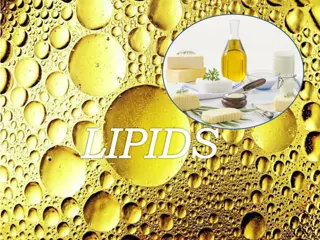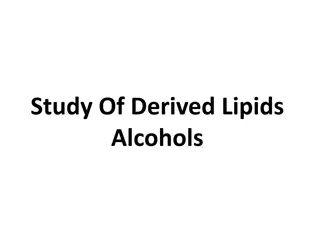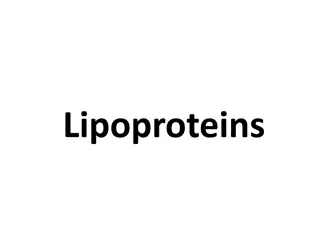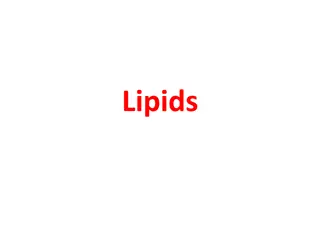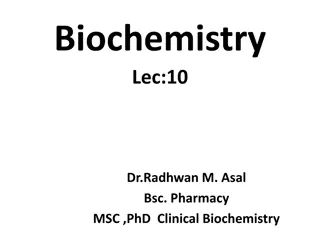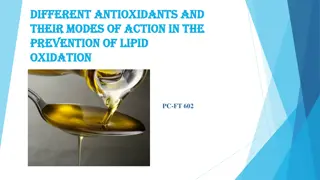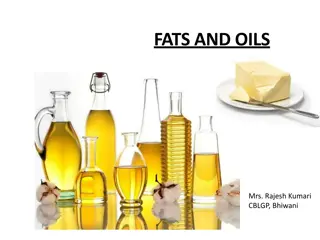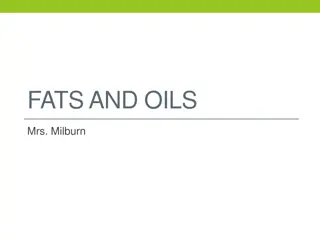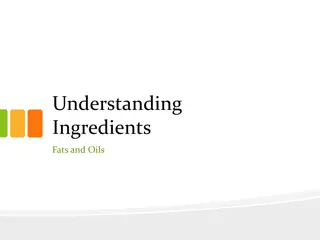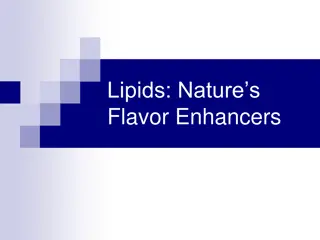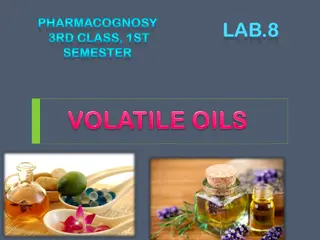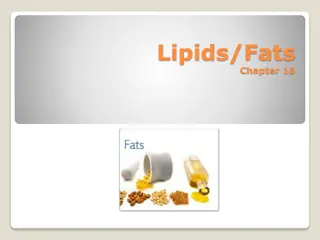Understanding Lipids: Waxes, Fats, and Fixed Oils
Lipids are organic compounds like waxes, fats, and fixed oils found in plants and animals. Fixed oils are reserve food materials, while fats are solid at higher temperatures. These substances are esters of glycerol and fatty acids, with various components giving them unique properties and flavors. Chemical tests can identify fixed oils or fats, and adulteration in oils can be detected through specific tests.
Download Presentation

Please find below an Image/Link to download the presentation.
The content on the website is provided AS IS for your information and personal use only. It may not be sold, licensed, or shared on other websites without obtaining consent from the author. Download presentation by click this link. If you encounter any issues during the download, it is possible that the publisher has removed the file from their server.
E N D
Presentation Transcript
LIPIDS (Waxes. Fats & Fixed Oils) Castor oil, Chaulmoogra oil, Wool Fat & Beeswax UNIT V PHARMACOGNOSY COMPILED BY DR NISHA SHARMA
LIPIDS Substances of animal or plant origin and comprise of fixed oils, fats and waxes. Large and diverse group of naturally occurring organic compounds that are related by their solubility in nonpolar organic solvents FIXED OR FATTY OILS: They are reserve food materials of plants and animals. When liquid at 15.5 -16.5 C, called fixed oils; Which are solid or semi-solid at above temperature are fats. Fixed oils, derived from plant sources, occur generally in seeds. Properties: 1. Fixed oils are thick, viscous, yellow coloured liquids with characteristic odor. 2. They are non-volatile and cannot be distilled. 3. They do have food value and can be saponified. 4. They turn rancid on storage due to free acidity. 5. Fixed oils and fats are insoluble in water and ethyl alcohol, but soluble in organic solvents like chloroform; ether; petroleum-ether and benzene.
LIPIDS 6. Fats and oils are esters of glycerol (three carbon trihydric alcohol) and various straight chained monocarboxylic acids, known as fatty acids. The fatty acids of natural fats have 4 - 24 carbon atoms (and any even number). These fatty acids may be saturated, monounsaturated, polyunsaturated or cyclic unsaturated. The cyclic unsaturated fatty acids are hydnocarpic, chaulmoogric and prostanoic. 7. They also contain various components in minor quantities such as vitamins, sterols, anti-oxidants, phospholipids, pigments and traces of hydrocarbons, and ketones, which are responsible for specific odours and flavours of these oils. 8. Fats have more % of saturated acids
LIPIDS Chemical Tests for Identification of Fixed Oils or Fats Fixed oils or fats can be confirmed by chemical test for glycerine which is produced by their hydrolysis. The test is performed as under: 1. Using Sodium Hydroxide: Mix 1 ml 1% CuSO4solution + 5 drops of fixed oil/fat + add 5 drops of 10 % NaOH clear blue solution (glycerine is present) The cupric hydroxide formed in the reaction does not precipitate out as it is soluble in glycerine. 2. Using Sodium Hydrogen Sulphate: 5 drops of sample in test tube + add pinch of sodium hydrogen sulphate Pungent odor indicates glycerine is present. The pungent odor is due to the formation of acrolein.
LIPIDS ADULTERATION IN OILS/FATS/WAXES 1. Detection of sesame oil as adulterant: 2 ml oil + 1 ml HCl, 1 % sucrose, keep aside for 5 min. pink color in the acid layer presence of sesame oil. 2. Detection of cotton seed oil as adulterant by Halphen's test: 2 ml oil + 2.5 ml alcohol +2.5 ml sol. of S in CS2(1%) + Heat pink or red color presence of cotton seed oil 3. Detection of karanja oil as adulterant: 5 ml sample oil + 10 ml ethyl alcohol +5 drops of FeCl3,Shake vigorously for 2 min. allow to stand for 2 hours light blue to dark color in alcoholic layer presence of karanja oil or any other oil containing phenolic group. 4. Detection of castor oil as adulterant: 1 ml sample + acidified petroleum ether (60 - 80 C), Shake, + add drop of ammonium molybdate solution white turbidity indicates the presence of castor oil.
LIPIDS ADULTERATION IN OILS/FATS/WAXES 5. Detection of argemone oil as adulterant: It is an adulterant to mustard oil. FeCl3reacts with argemone oil in HCl medium to produce small needle shaped reddish brown crystals. However, if content of argemone oil is less than 1 per cent, needle-shaped crystals can be observed under microscope. 6. Detection of linseed oil as adulterant: 1 ml sample + dissolved in 5 ml CHCl3+ 1 ml liq. Br2, stopper, cool in ice bath + add1.5 ml rectified spirit +10 ml ether, shake for 30 min. appearance of precipitate (due to formation of hexabromide) presence of linseed oil. 7. Detection of mineral oil as adulterant: 1 ml oil or fat + add 25 ml alcoholic KOH + Boil in water bath till clear. Transfer to wide mouth test tube + add 25 ml dist. H2O along side of the test tube, shake tube during addition of H2O turbidity indicates presence of mineral oil.
WAXES Waxes are unctuous, fusible, variably viscous solid substances, with characteristic waxy lustre. These are esters of fatty acids with high weight monohydric alcohol, such as cholesterol, cetyl alcohol, melissyl alcohol, etc. They are insoluble in H2O, soluble in most organic solvents. Obtained from vegetable and animal sources (a) Vegetable: Seasal wax, carnauba wax, Japan wax, bayberry wax (b) Animal: Spermaceti, bees wax, wool fat Difference between fats and waxes: fats may be saponified by either aqueous or alcoholic alkali, but waxes are only saponified by alcoholic alkali. Waxes are unsuitable for internal consumption, as no enzyme in human body to hydrolyse
Analytical Parameters for Oils and Fats 1. Iodine value: Defined as weight of I2absorbed by 100 parts by weight of the sample of fat or oil. I2 value is a measure of the extent of unsaturation. Susceptibility to rancidity ses for the oil or fat with higher I2values. 2. Saponification value: Defined as the number of mg of KOH required to neutralize the fatty acids resulting from complete hydrolysis of 1 g of the sample of oil or fat. Applied for butterfat, coconut oil in which lower fatty acids glycerides occur in high content. 3. Hydroxyl value: Defined as number of mg of KOH required to neutralise the CH3COOH capable of combining by acetylation with 1 g sample of fat or oil.
Analytical Parameters for Oils and Fats 4. Acetyl value: Number of mg of KOH required to neutralize CH3COOH obtained when 1 g of sample acetylated oil is saponified. Except castor oil (acetyl value 150), most of the oils and fats have low acetyl value (3 - 15). 5. Unsaponifiable matter: It is the matter present in fats and oil, which after saponification by caustic alkali and subsequent extraction with an organic solvent, remains non-volatile on drying at 80 C. It includes sterols (phytosterol and cholesterol), oil soluble vitamins, hydrocarbons and higher alcohols. Paraffin hydrocarbons can be detected by this method as adulterants. 6. Acid value: Defined as the number of mg of KOH required to neutralise the free acids present in 1 g sample of fat or oil. Rancidity causes free fatty acids liberation, hence acid value is used as an indication of rancid state. 7. Peroxide value: It is a measure of peroxides present in oil. A peroxide value is generally less than 10 meq/kg in fresh samples of oil. Due to temperature or storage, rancidity occurs causing increase in peroxide values.
Analytical Parameters for Oils and Fats 8. Kreis test (rancidity index): Due to rancidity, epihydrin aldehyde or malonaldehyde are increased which are detected by Kreis test using phloroglucinol which produces red color with oxidized fat. 9. Ester value: Defined as number of mg of KOH required to combine with fatty acids which are present in glyceride form in 1 g sample of oil or fat. Difference between saponification value and acid value is ester value. 10. Reichert Meissle Value: This value is a measure of volatile water soluble acid contents of the fat. It is defined as number of ml N/10 KOH required to neutralise the volatile water soluble fatty acids obtained by 5 g fat. 11. Polenski value: It is defined as the number of ml of N/10 KOH solution required to neutralise water insoluble, steam distillable acids liberated by hydrolysis of 5 gm of fat.
CASTOR OIL: RICINUS OIL Castor oil is fixed oil obtained by cold expression of seeds of Ricinus communis, family Euphorbiaceae. Preparation : Prepared by 2 methods 1st: By crushing whole or decorticated seeds in hydraulic presses 2ndknown as Ghani: manually operated screw press driven by bullocks. Obtained oil is Non-medicinal castor oil. Seeds are graded, made free of impurities, decorticated , hulls are removed. If seeds not decorticated, the manurial value of the cake ses. For medicinal purposes, seeds are decorticated, it improves the color of oil & helps control acid value. Decorticated seeds are pressed at pressure of 2 tonnes/ sq. inch, helps in extracting out 30% of the oil present in the seeds at room temperature. The oil is called as cold drown oil, steamed at 80 C, destroys the enzyme lipase & ricin (toxic protein), bleached, de acidified with Na2CO3to remove free fatty acid, washed with hot water before steaming to remove the mucilagenous matter, finally treated with activated charcoal, filled
CASTOR OIL: RICINUS OIL Description : Color: Pale yellow or almost colorless liquid. Odor: Slight and characteristic. Taste: First bland then acrid, nauseating. It is viscous, transparent liquid. Soluble in alcohol; miscible in CHCl3, ether, gl. CH3COOH, insoluble in mineral oil. Chemical Constituents: Seeds contain 35 50% of castor oil. Triglyceride of ricinoleic acid (80%). Fatty acids represented by isoricinoleic, linoleic, stearic and isostearic acids. Viscosity of the castor oil is due to ricinoleic acid. Ricinoleic acid: CH3 (CH2)6 CHOHCH2CH=CH(CH2)7COOH. Also contain heptaldehyde (heptanal) undecenoic acid and sebacic acid. Identification Test: 1.It mixes with its volume of light petroleum ether (40 60 C) but insoluble in double the volume of petroleum ether. 2. Oil+ equal volume of ethanol clear liquid obtained cool at 0 C, store for 3 hrs liquid remains clear (distinction from other fixed oils).
CASTOR OIL: RICINUS OIL USES: Fatty acid : ricinoleic; heptaldehyde and undecenoic acid prepared from castor oil. Used in preparation of paints, enamel, varnishes, grease, polishes, printing ink, hydraulic, brake spirit. cathartic property is due to irritant action of ricinoleic acid. Used in abortificient paste and ricinoleic acid is used in contraceptive creams and jellies. Atropine and cocaine for opthalmic use are suspended in castor oil. As an emollient in preparation of lipsticks, imparts transparency to soaps, for manufacture of sebacic acid (raw material for resins ), in production of rigid, semi-rigid foams and urethanes called elastomers, used for trolley wheels, as basic raw material to mfg. nylon - 11. Castor cake used as source of enzyme lipase. Castor oil does not freeze at lower temperature, is valuable as lubricant.
Chaulmoogra oil/ Hydnocarpus Oil/ Gynocardia Oil Biological Source: It is fixed oil obtained by cold expression method from ripe seeds of the plant Taraktogenos Kurzii, and Hydnocarpus anthelmintic, Hydnocarpus heterophylla & other species of the Hydnocarpus, family Flacourtriaceae. Method of Preparation: Seeds are sub-ovoid, obtusely angular and 2 cm in length. The seeds contain 40-45% fixed oil. Seeds are decorticated by machine after grading the kernels are pressed with the hydraulic press and the oil obtained is filtered. Description: Color: Yellow to brownish-yellow liquid Odor: Characteristic, Taste: Somewhat acrid, Solubility:slightly soluble in alcohol, soluble in CHCl3, ether, benzene & CS2. It is soft white solid below 25 C.
Chaulmoogra oil/ Hydnocarpus Oil/ Gynocardia Oil Chemical Constituents: Contains chemical esters of unsaturated fatty acids of chaulmoogric acid (27%) & hydnocarpic acid (48%), gorlic acid, about 20.0% of proteins, cyanophoric glycosides & glycerides of palmitic acid and oleic acids. Uses: Strong bactericidal effect, against Mycobacterium leprae, & M. tuberculosis, treatment of TB, leprosy, psoriasis & rheumatism, seeds contain cyanophoric glycosides oil cake is not edible and can not be used as food for animals. Storage: stored in closed containers away from light and in cool place. Substituted plants in India: Hydnocarpus wightiana (WestBengal) Hydnocarpus alpine (Karnataka, Kerala & Tamil Nadu). Dose: 0.3 to 1 ml; intramuscular or subcutaneous injection.
WOOL FAT: Lanolin, Adeps Lanae Botanical Source: Hydrous wool fat is purified fat like substance obtained from the wool of the sheep Ovis aries Linn. family Bovidae. It contains between 25-30% of water. It is the secretion of sebaceous glands of sheep deposited onto the wool fibres. Method of Preparation: Raw wool contains about 31% wool fibres, suint or wool sweat (K salts of fatty acids), about 32 % earthy matter and about 25% wool grease or crude lanolin. Crude lanolin is separated by washing with H2SO4or suitable organic solvent or soap solution., purified and bleached. The product known as anhydrous lanolin or wool fat. The hydrous wool fat is produced by intimately mixing wool fat with 30.0% water. Description: Color: Whitish-yellow, Odor: Faint and characteristic Taste: Bland Extra Features: It is found in the form of ointment like mass and on heating in water bath, it separates into two layers.
WOOL FAT: Lanolin, Adeps Lanae Solubility: insoluble in water, soluble in CHCl3& solvent ether with separation of water. Chemical Constituents: Complex mixture of esters and polyesters of 33 high molecular weight alcohols & 36 fatty acids. Hydrous wool fat contains mainly esters of cholesterol and isocholesterol with carnaubic, oleic, myristic, palmitic, lignoceric, and lanopalmitic acids. It also contains 50 % of water. Identification Test: 0.5 g sample + CHCl3 + 1 ml acetic anhydride + 2 drops of H2SO4 green color presence of cholesterol. Uses: The lanolin is mainly used as water absorbable ointment base. It is a common ingredient and base for several water soluble creams and cosmetic preparations. It can be allergic also.
YELLOW BEESWAX/ CERA FLAVA Biological Source: It is purified wax obtained by melting the walls of the honey comb of the bees Apis mellifica and other species of Apis, belonging to family Apidae. Preparation: combs & capping of honeycomb are broken & boiled in soft water, then enclosed in porous bag weighted to keep under water, boiling causes oozing of the wax, gets collected outside the bag & forms a cake after cooling. The debris on outer surface, removed by scraping. Purified by heating in boiling H2O/ dilute H2SO4& settling, process repeated & finally wax is skimmed off. bleach the wax by treating with H2O2, chromic acid, ozone, charcoal, chlorine or KMnO4,natural bleaching exposing the wax to sunlight. Description: Color: Yellow to yellowish-brown Odor: Agreeable and honey-like
YELLOW BEESWAX/ CERA FLAVA Solubility: insoluble in H2O, soluble in hot alcohol, ether, CHCl3, CCl4, fixed & volatile oils. Chemical Constituents: consists of esters of straight chain monohydric alcohols with straight chain acids. Chief constituent of the bees wax is myricin i.e. myricyl palmitate (about 80 %). Free cerotic acid (about 15%), small quantities of melissic acid and aromatic substance cerolein are the other constituents. Indian bees wax is characterised by its low acid value, while European bees wax has the acid value of 17 to 22. Chemical Test: Saponification claud test: 0.5 gm+ 20 ml aq. caustic soda solution+ boil for 10 minutes. Cool, No turbidity
YELLOW BEESWAX/ CERA FLAVA Uses: used in preparation of ointments, plasters and polishes, in ointment for hardening purposes & manufacture of candles, moulds & dental & electronic industries, in lipsticks & face creams. It is an ingredient of paraffin ointment IP. Adulterants: colophony, hard paraffin, stearic acid, Japan wax, spermaceti, carnauba wax & other substances. Adulteration can be detected on the basis of solubility and melting point. The genuine wax should not give turbidity when 0.5 g of wax is boiled with 20 ml of aqueous caustic soda for 10 minutes and cooled. White beeswax: Obtained by bleaching yellow bees wax, should not be used for ophthalmic purposes.


